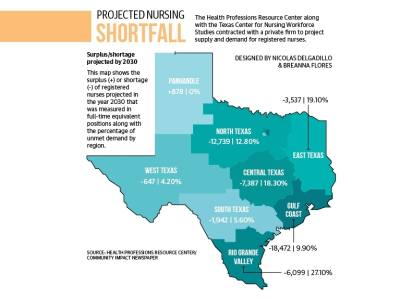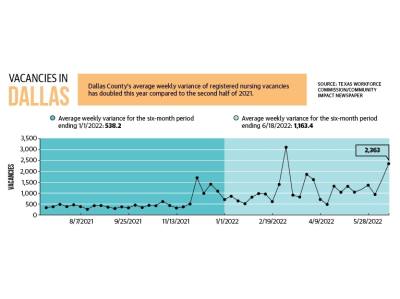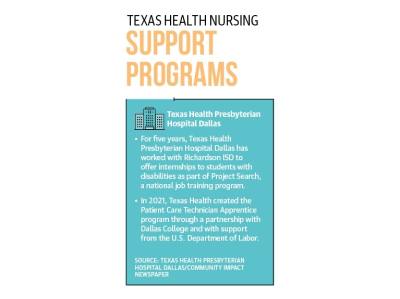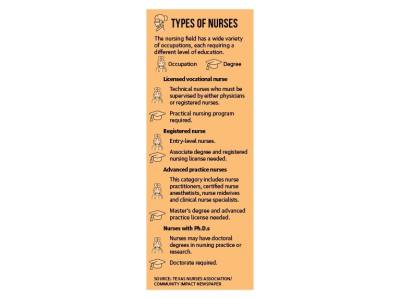Officials with Texas Health Resources, the parent company of Texas Health Presbyterian Dallas, said they have been working hard to provide opportunities for those wishing to join the field.
“It is incumbent upon all health care systems and others to find new ways to attract and retain staffing,” said Mark Morales, chief learning officer for Texas Health Resources. “Maintaining such a culture has always been a top priority to Texas Health and we are committed to continuing to look for new solutions and collaborations that address these challenges.”
Projections from the Texas Department of Health and Human Services show hospitals across the state are dealing with a shortage of nurses and other full-time employees. The demand for full-time registered nurses is expected to increase to nearly 350,000 over the next decade, according to projections from the state.
That could leave the state health care industry with a staffing shortage of more than 57,000 full-time employees by 2032, according to the DSHS data. Based on these state estimates, more than 16% of the projected demand for registered nurses in 2032 will not be met.
“The health care workforce is at a critical standpoint,” said Stephen Love, president and CEO of the Dallas-Fort Worth Hospital Council. “The COVID-19 pandemic took a very heavy toll on health care teams, especially on the front lines. As a result, many have suffered stress, trauma, burnout and behavioral health challenges.”
Hospital officials said they are actively working to alleviate staffing shortages on several fronts, including addressing burnout and retention; expanding recruitment efforts; and increasing educational opportunities for nurses.
Retention
Easing the nursing shortages will involve producing more available nurses while also creating an environment to better retain existing employees, according to Texas Nurses Association CEO Cindy Zolnierek.
“I think health care organizations are doing a lot to try to support particularly diverse staff because if they support their staff, they’re likely to be loyal and want to stay with that organization,” Zolnierek said.
Zolnierek said the COVID-19 pandemic has been a factor in the shortages in the workforce.
“The work environment during COVID[-19] was so intense and so difficult for nurses that some are leaving nursing, or they may be taking a temporary break,” she said. “Some [nurses] are of an age where they’re able to retire or retire early, and we don’t fully understand the impact of that.”
Incredible Health, a staffing firm that partners with hospitals and health systems to help nurses get hired, analyzed data from more than 400,000 nurse profiles in its system and surveyed more than 2,500 registered nurses in the U.S. in February.
Data from the survey showed 34% of the nurses surveyed reported it is very likely they will quit their job by the end of this year.
Of the nurses surveyed, 44% cited burnout and a high-stress environment as the reason for their desire to leave their jobs. Nearly one-third of nurses said they plan to leave the field altogether or retire, while 42% of nurses surveyed have started a new nursing role since January 2021.
Many professional groups, such as the Texas Nurses Association and the Texas Hospital Association, are paying attention to health care workers’ mental health, Zolnierek said. Hospitals such as Texas Health Presbyterian Dallas are also working to increase retention by addressing the issue of burnout among staff, officials said.
According to a study on clinicians’ well-being and resilience by the National Academy of Medicine, changes designed to help reduce burnout have been recommended for medical staff, including investing in more routine assessments of workforce stress as well as destigmatizing and supporting mental health. The study also recommends that focusing on well-being should be a long-term value.
“Let’s not wait until we get to burnout,” Zolnierek said. “We’re looking at how we can support the well-being of our workforce.”
Hospitals are also working on retaining staff to grow continued workforce, said Kelly Martin, vice president of human resources for Texas Health Resources.
“Texas Health knows that hiring employees is only the first step in overcoming staffing,” Martin said. “Retaining employees, especially during the taxing times we’ve experienced in the pandemic, means systems must treat employees well [and] provide opportunities for career growth and resources to help care for their physical and mental health.”
Recruitment
At White Rock Medical Center in Lakewood, the nursing shortages have forced the hospital to look for new ways to entice nurses to join the hospital. Jenny Humpal, chief nursing officer for White Rock Medical Center, said the hospital has started to expand its recruitment efforts internationally to help hire qualified nurses.
Humpal said White Rock Medical Center was hosting approximately 60 nurses from other countries in late June.
“The safety of our patients is always our highest priority, and therefore we have worked hard to ensure that we have the proper staffing levels and qualified nurses to care for our patients,” Humpal said.
To help fill gaps in the workforce, hospitals have relied on supplemental staffing through agencies, something Zolnierek said has been done on a smaller scale for decades.
This supplemental staffing has resulted in an increase in hiring for traveling nurses, or agency nurses. These traveling nurses can often earn twice as much as those employed by the hospital because of the shorter assignments.
“It became a vicious cycle where nurses were leaving hospitals to travel because they could make more money and have different experiences and travel to different places,” Zolnierek said. “In turn, it made the shortage in hospitals worse.”
Officials at Texas Health Presbyterian Dallas said they prefer having full-time employees over travel nurses. But travel nurses have been invaluable during the pandemic and will continue to be, Love said.
“We’re not faulting nurses for wanting to have that mobility, the ability to travel or to [become traveling nurses] for their personal economic point of view,” he said.
Educational efforts
To keep employment high, hospitals across the state are using existing partnerships with colleges and universities to help fill staffing shortages, according to Candy Baptist, director of the career transformation center for Texas Health Resources University.
“Texas Health works with a variety of secondary schools to provide students opportunities to intern at our facilities,” Baptist said.
Texas Health Presbyterian Hospital Dallas has partnered with Richardson ISD since 2017 to offer internships to students with disabilities as part of Project Search, a national job training program. Most of the students have found subsequent employment, including many within Texas Health Dallas, Baptist said.
Texas Health Resources also has apprenticeship programs to guide graduates into health care careers.
In 2021, Texas Health Resources created the Patient Care Technician Apprentice program through a partnership with Dallas College and with support from the U.S. Department of Labor. The program has two different “earn as you learn” tracks, allowing candidates to be hired and paid a wage while they are learning their job in the classroom.
Love said a lack of nursing school faculty is also hurting the profession.
“So many qualified applicants ... for baccalaureate and graduate programs can’t really get accepted in nursing school for lack of the faculty that’s needed [to teach them],” Love said.
Now is a good time for young nurses to enter the workforce as many hospitals are hiring new graduates, Zolnierek said.
“There are all kinds of opportunities,” she said.









